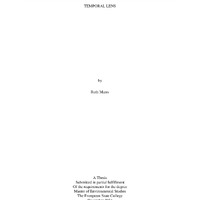Examining Canopy Gap Dynamics in Central Oregon Through a Multi-Temporal Lens
Item
- Title
- Description
- Date
- Creator
- Identifier
-
Examining Canopy Gap Dynamics in Central Oregon Through a Multi-Temporal Lens
-
In forest ecosystems, disturbances create variability through their influence on overstory and understory species. Canopy gaps created by smaller disturbances such as moderate to severe wildfires, snow, or wind, leading to the death or injury of one to several trees, can provide opportunities for niche diversification by encouraging regeneration of shade intolerant species to take advantage of increased sunlight, increasing overall species diversity. In early 2020, a severe snow event struck the Horace J. Andrews (HJA) Experimental Forest in central Oregon, leading to death and injury of many trees throughout several experimental watersheds. Here we analyze vegetation plot data and LiDAR data collected in 2008, 2016, and 2020, to determine influences on the presence, size, and frequency of canopy gaps over time in order to determine the effect of the 2020 snow event. We analyzed the influence of elevation, stand density, and canopy roughness on the presence of canopy gaps among three experimental watersheds containing impacted permanent study plots, as well as the influence of these variables as well as stand age on the size and frequency of gaps across all watersheds. The presence of canopy gaps increased with canopy roughness across all watersheds for all years, while elevation and density did not show consistent patterns, or clear influence due to the 2020 snow event. However, after the snow event, more gaps were detected at lower elevations, and the gaps that were detected at these lower elevations tended to be smaller than those found at higher elevations. The number of gaps increased with stand density and with canopy roughness. While our results do not depict a drastic change in how our study variables influence the presence, size, and frequency of canopy gaps before and after the snow event, the newly recorded increase of small canopy gaps at lower elevations in 2020 reflects the influence of the heavy, wet snow.
-
December 2024
-
Ruth Mares
-
Mares, Ruth_MES Thesis_December 2024
Position: 106 (40 views)

